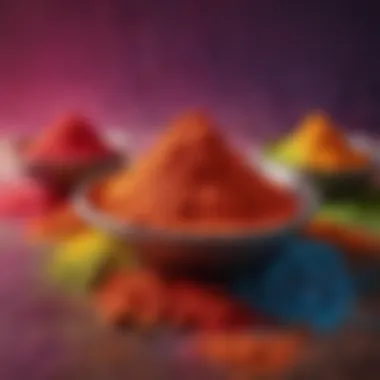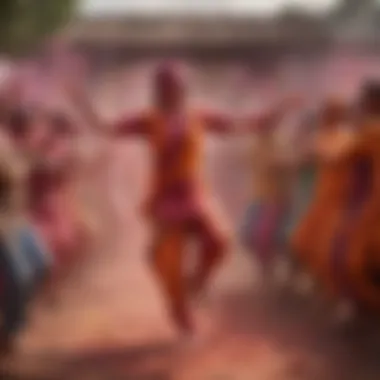Exploring Holi: Significance, Traditions, and Myths


Intro
Holi, the festival of colors, is a vibrant celebration that marks the arrival of spring. Its roots stretch deep into ancient Indian traditions, and it embodies various cultural significances throughout the subcontinent. Holi transcends mere festivity; it serves as a medium of expressing joy and community bonding. The festival reveals a glimpse into the sociocultural fabric of India, showcasing not only its mythological origins but also its regional variations.
Through this exploration of Holi, we delve into the stories that give life to this festival. Mythologies such as that of Prahlad and Hiranyakashyap reflect underlying themes of good versus evil and the triumph of virtue. The celebration encourages unity among diverse groups, highlighting a spirit of forgiveness and bringing together people from various backgrounds.
In addition to the historical background, understanding the traditional customs during Holi provides insight into its ongoing relevance. These customs may vary regionally, yet they all share a common thread of joy and color. With its socio-historical importance, Holi extends beyond traditional boundaries. It resonates with contemporary values and continues to inspire joy across generations.
Prelude to Holi
Holi represents more than a festival; it is a celebration of life, color, and joy rooted deeply in cultural traditions. This festival, often referred to as the Festival of Colors, is observed primarily in India, though its popularity has spread worldwide. Understanding the essence of Holi allows us to appreciate its significance beyond mere festivities.
The key elements of Holi's importance lie in its reflections of joy, forgiveness, and the renewal of relationships among individuals. It marks the onset of spring, symbolizing the victory of good over evil, and encourages the destruction of old resentments. For many, it is a time to reset personal relationships and foster new connections.
The celebration of Holi brings communities together, breaking down social barriers. Everybody participates, regardless of age, caste, or background. This collective experience fosters unity and strengthens social bonds, making it a quintessential moment for social harmony.
In many regions across India, Holi is closely linked with myths that illuminate deeper philosophical underpinnings. The rituals and customs associated with it carry historical significance that impacts both culture and community. Through this exploration, we aim to unravel Holi's multifaceted narrative, its rich heritage, and the diverse ways in which people observe it.
The Essence of Holi
Holi's essence is encapsulated in the idea of celebrating the triumph of good over evil, which resonates through its associated legends and rituals. The joyous application of colored powders signifies the arrival of spring and a time of rejuvenation. Participants throw vibrant colors on one another, filling the atmosphere with a sense of exuberance.
The act of playing with colors is not merely for merriment; it carries profound meanings. Each color represents different emotions and traditions. For example, red symbolizes love and fertility, while green represents harmony and new beginnings. The diversity of colors mirrors the diversity of human emotions and relationships.
Moreover, Holi serves as an impetus for community bonding. Families and friends gather to celebrate, share meals, and participate in cultural events, creating a sense of belonging. Taking part in various rituals, such as the lighting of bonfires on the eve of Holi (known as Holika Dahan), signifies the burning away of negativity.
Holi also extends beyond cultural confines, as many people celebrate it in urban centers worldwide. The festival adapts to different contexts while preserving its core message. In summary, the essence of Holi is a rich tapestry woven from joy, tradition, relationships, and cultural heritage.
Historical Origins of Holi
The historical origins of Holi are significant in understanding its evolution and the profound impact it has on various communities. This section examines foundational stories, ancient sources, and the variations in how different regions perceive the festival. The background informs about the interplay between mythology and community practices, emphasizing how ancient narratives shape modern celebrations.
Ancient Texts and Writings
Holi’s roots can be traced in numerous ancient texts, including religious scriptures like the Puranas and Mahabharata. These texts provide insights into the cultural fabric of ancient India. They discuss the themes of love, devotion, and the triumph of good over evil, central to the festival. The reference to color in these texts symbolizes both joy and the vibrancy of life, which aligns with Holi’s characteristic festivities.
Additionally, inscriptions from historical scholars highlight the rituals associated with Holi. For example, the Natyashastra, an ancient treatise on the performing arts, reflects on the importance of spring festivals and the associated revelries. Through careful reading of these materials, one can appreciate Holi not merely as a festival but as a continuation of rich traditions spanning centuries.
The Legend of Holika and Prahlad
One of the most prominent legends associated with Holi is that of Holika and Prahlad. This tale originates from Hindu mythology and represents the eternal battle between good and evil. Prahlad, a devotee of Lord Vishnu, is depicted as unwavering in his faith, despite his father, King Hiranyakashipu’s, fierce opposition to Vishnu worship.


To demonstrate the futility of evil and protect Prahlad, Holika, the king's sister who possessed a boon to resist fire, is tricked. The legend states that when Holika attempts to burn Prahlad during the festival, she is consumed by flames instead, while he emerges unscathed. This powerful narrative symbolizes hope, faith, and protection and reinforces the core moral: good ultimately prevails over evil.
Regional Variations in Mythology
The story of Holi is not uniform across India; various regions have their interpretations and adaptations reflecting local customs and beliefs. In some Northern states, the focus may be on the divine play of Radha and Krishna, showcasing their playful interactions with colors. In contrast, Southern regions may have different ceremonies that emphasize local deities, leading to diverse expressions of the festival.
These regional variations contribute to a richer tapestry of Holi celebrations, each unique yet sharing the underlying themes of joy and renewal. This multiplicity also invites deeper engagement from different communities, allowing everyone to relate to the festival in their own way. Understanding these distinctions highlights the flexibility and inclusivity of Holi, making it a beloved event for many.
"Holi celebrates love and the arrival of spring, intertwining deeply rooted customs that resonate across various cultures and traditions."
Cultural Significance of Holi
The cultural significance of Holi extends beyond mere celebration; it embodies deep-rooted values that resonate across various dimensions of society. This vibrant festival highlights themes of unity, renewal, and the triumph of good over evil. Holi serves as a reminder of the values that bind people together, regardless of their backgrounds. In contemporary times, the festival has, in some ways, become a universal symbol of cultural integration and joy.
Symbol of Victory of Good Over Evil
Holi is primarily seen as a manifestation of the victory of good over evil. This theme is articulated through the story of Prahlad and Holika, which is central to the festival's mythology. Prahlad's unwavering devotion to Lord Vishnu represents the triumph of faith. In contrast, Holika, who embodies malicious intent, ultimately meets her demise. This narrative celebrates the idea that no matter how powerful evil may seem, righteousness will always prevail.
The symbolism here is not just limited to a story; it resonates with individuals and communities, offering them hope and inspiration. Every year, this story is retold, rejuvenating the profound message embedded within it. During Holi, participants often chant and celebrate this victory, reinforcing the moral compass that guides their lives. This aspect of the festival plays a crucial role in promoting positive behavior and ethical conduct across societies.
Impact on Social Harmony
Holi acts as a catalyst for social harmony. The very essence of the festival breaks down barriers, whether they are social, economic, or ethnic. When people gather to celebrate Holi, they actively participate in a collective experience that fosters inclusivity. The festival encourages interactions between different groups, creating connections that might otherwise be lost in the hustle of daily life.
Furthermore, during Holi, societal hierarchies often dissolve. Individuals from various backgrounds join together, sharing colors and laughter. This companionship promotes goodwill and understanding. The celebration becomes a platform for people to express themselves freely, which is often stifled in regular circumstances.
"Holi teaches us to rise above our differences and embrace a more united existence."
Thus, the impact of Holi on social harmony extends beyond the day of the celebration. It influences ongoing relationships and strengthens communities. By engaging in shared traditions, people cultivate mutual respect and a sense of belonging, which are essential for cohesive societies.
In summary, the cultural significance of Holi reflects a complex interplay between historical narratives and social dynamics. It highlights the enduring qualities of resilience, kindness, and togetherness, which are essential in today’s fragmented world.
Traditional Practices During Holi
The significance of traditional practices during Holi cannot be overstated. They serve not just as rituals but as a means to unite people in celebration. Each participant shares in communal joy, reinforcing social bonds. Preparations for the festival begin weeks in advance, filled with anticipation and vibrant creativity. Traditional practices enhance the festive atmosphere, and they closely link to the festival's cultural roots.
Preparation for the Festival
Preparing for Holi involves various practical and symbolic activities. Homes are often cleaned and decorated as a way of welcoming positivity. People begin to gather materials like colored powders, known as "gulal," and water balloons. Vendors often prepare special sweets, including gujiya, which is a savory pastry filled with sweetened khoya and dry fruits. The buying of these items contributes to local economies and reflects the collaborative spirit surrounding the festival.
Celebrations Across India
Holi's celebrations vary significantly across India. In some regions, people participate in elaborate outdoor festivities, while in others, celebrations are more intimate and family-oriented. For instance, in Mathura and Vrindavan, where the festival has deep mythological roots, the celebrations extend over several days and include public reenactments of the divine love story between Radha and Krishna.
Other regions, like Punjab, focus more on community gatherings, dance, and music intertwined with the celebrations. Clearly, the local customs infuse the festival with a unique essence that speaks to the cultural diversity of India.


Rituals and Offerings
The rituals associated with Holi often carry spiritual undertones. Many families participate in the ceremonial lighting of the Holika Dahan, signifying the destruction of evil from within. This event is accompanied by the singing of traditional songs and the throwing of grains into the fire as offerings. Additionally, devotees may perform puja, or worship, offering prayers and sharing sweets as a gesture of goodwill. Such actions reinforce community and family bonds while grounding the festival in deep-seated traditions.
"Holi is not about mere celebration; it is an integration of the past, present, and community spirit."
In summary, the traditional practices during Holi are integral to making the festival a rich experience. They bring people together, offer spiritual connections, and encapsulate the essence of joy and community.
Food and Drink During Holi
The festival of Holi is not only a celebration of colors but also a profound expression of communal spirit and togetherness, prominently reflected in the vibrant array of food and drink enjoyed during this occasion. This section will explore how traditional food plays a crucial role in the festivities, highlighting specific dishes, their cultural significance, and the overall experiences they foster among participants.
Traditional Dishes Associated with Holi
The dishes prepared during Holi are rich in flavor and varied, showcasing the cultural diversity of India. Some notable traditional foods include:
- Gujiya: This sweet dumpling, filled with a mixture of khoya and dried fruits, is a staple during Holi. Its rich sweetness symbolizes the joy and festivity of the occasion.
- Mathri: A savory fried snack, mathri is spiced and crisp, serving as a perfect accompaniment to sweet beverages like thandai.
- Bhang: While not a food per se, bhang-infused dishes, such as bhang lassi and bhang laddoo, add a unique twist to the festivities. It is often consumed as part of the revelry.
- Puran Poli: This sweet flatbread, filled with a mixture of jaggery and lentils, resonates with families that gather to celebrate together.
Each of these dishes is not merely food; they embody the festivities. Families often come together to prepare these meals, reinforcing bonds as they share recipes and stories passed down through generations. The enjoyment of these foods often reflects shared joy and connection, vital aspects of the Holi celebration.
Holika Dahan and Its Culinary Significance
Holika Dahan, a ceremonial bonfire lit on the eve of Holi, holds deep cultural significance. In addition to its religious aspects, it offers an occasion for community gatherings centered around food. The flames symbolize the burning away of evil, much like the heart of the festival itself.
Culinary preparations connected to Holika Dahan vary by region but often include:
- Roasted corn: This popular snack symbolizes the warmth and community spirit associated with the bonfire.
- Potatoes and other root vegetables: These are often roasted, echoing the earthy flavors of the festival.
The act of sharing food during Holika Dahan fosters a sense of unity among participants. It is a time to connect, share stories, and reflect on the significance of the festival, enhancing the overall experience for both makers and consumers.
Holi's culinary traditions are reminders of the importance of familial bonds and communal ties, imbuing the festivity with warmth beyond the vivid colors.
In summary, the culinary landscape of Holi is a mosaic of flavors that contributes to the festival's allure. The dishes and traditions cultivated during this time cultivate connections that transcend mere celebration, linking people through shared experiences centered around food.
Holi in Contemporary Society
The festival of Holi, while firmly rooted in its religious and cultural history, has also adapted to the modern world. Its significance extends beyond celebration; it serves as a platform for social interactions and community bonding. In contemporary society, Holi is a bridge that connects generations and fosters an environment of inclusivity. Today, it brings together people from diverse backgrounds, ensuring a rich tapestry of traditions and practices.
Global Celebrations and Adaptations
Holi has transcended its geographic and cultural origins. In recent years, the festival has gained global recognition. Major cities around the world now host Holi events, attracting an international audience. For example, in the United States, cities like New York and San Francisco celebrate Holi with vibrant color runs and music festivals. These adaptations maintain the core essence of Holi while allowing for new interpretations. Global participants often incorporate local elements, further enriching the festival.


Some specific adaptations include:
- Color Runs: Introducing the idea of running through clouds of colored powder.
- Music Festivals: Featuring DJs and live performances, blending traditional Holi music with contemporary sounds.
- Culinary Innovations: Local dishes infused with ingredients that resonate with the spirit of Holi.
These iterations not only celebrate diversity but also invite reflection on the shared values of joy and unity that Holi represents.
Holi in Urban Settings
In urban environments, Holi transforms into a communal experience where traces of traditional celebrations can be seen. Large gatherings occur in parks and public spaces. Urban dwellers partake in organized events that include music, dance, and food stalls. This change brings accessibility to the festival, allowing those who may not have familial connections to participate in the revelry.
Even in crowded city situations, one can witness:
- Street Celebrations: Streets lined with people throwing colors and dancing.
- Community Parties: Local organizations hosting events that draw neighbors together.
- Awareness Efforts: Initiatives focusing on the responsible use of colors and water conservation during festivities.
Importantly, urban Holi celebrations emphasize sustainability. Many groups promote eco-friendly colors and waste management, catering to the increasing awareness of environmental issues.
Holi has not just remained a festival; it has evolved as a statement of unity and collective spirit, transcending societal boundaries.
These urban adaptations reflect the holistic nature of a festival that, at its heart, honors community connection and shared joy. As Holi continues to adapt and thrive in contemporary settings, it remains a beacon of cultural significance and a testament to the power of celebration.
Environmental Considerations
The festival of Holi, with its vibrant colors and lively celebrations, raises important discussions on environmental impact. Such discussions are significant in understanding the balance between tradition and sustainability. The way Holi is celebrated can influence the ecosystem, allowing for reflection on practices that may not always consider environmental health.
Traditional vs. Modern Practices
Traditionally, Holi relied on natural ingredients for colors, using flowers, spices, and herbs. These natural colors not only added life to the celebration but were also eco-friendly. However, modern times have seen a shift toward synthetic colors, which often contain harmful chemicals. Some of these chemicals can cause skin irritation, and pollution, and even disrupt local water supplies. This transition often stems from convenience and mass production, but it comes at the expense of our environment.
Thus, it is crucial to address the differences between festivity methods. Communities can benefit from revisiting traditional practices while adapting them to suit contemporary lifestyles. Encouraging the use of herbal powders and natural dyes in modern celebrations can mitigate the negative effects of synthetic alternatives.
Sustainable Celebrations
Sustainable Holi celebrations are becoming increasingly important as awareness of environmental issues grows. Actions such as promoting biodegradable colors, reducing waste, and conserving water during festivities can help.
- Use of Eco-Friendly Colors: Many organizations now promote the use of eco-friendly colors made from turmeric, beetroot, and other natural sources. These options are safe for skin and the planet alike.
- Water Conservation: Traditional water fights during Holi can lead to wastage. Encouraging dry celebrations or water-efficient methods can greatly reduce consumption.
- Waste Management: Communities can implement waste sorting before and after the celebrations, ensuring proper disposal and recycling of materials used.
Ending
The conclusion of this article brings together the threads that define the essence of Holi, a festival rich in history and cultural relevance. Understanding the significance of Holi is paramount due to its layered meanings, which transcend mere celebration. This festival encapsulates a spectrum of values, from the triumph of good over evil to the fostering of community bonds.
Reflections on the Meaning of Holi
Considering Holi’s multifaceted meanings, it is essential to reflect upon how this festival shapes identities and cultures across regions. For many, Holi is a period of joyous reunion with family and friends, allowing individuals to momentarily escape daily life and immerse themselves in a vibrant atmosphere of colours and music. It reminds us of life's impermanence, encouraging the embrace of each moment as a celebration.
The significance of Holi also extends to its role in promoting social harmony. Amid the chaotic vibrancy of the festival, barriers of caste, class, and religion dissolve. People come together regardless of their differences, reaffirming the spirit of unity. This is especially important in contemporary society, where such divisions can often appear insurmountable.
Further, the ways in which traditions adapt reflect societal changes and concerns, such as environmental sustainability. By reevaluating practices linked to Holi, celebrations can respect ecological concerns while continuing to foster joy.
Ultimately, Holi serves as a reminder of both historical roots and evolving modern practices. It invites us to explore our connections to each other and to honour the communal experiences that enrich our lives.
"Holi is not just a festival but a celebration of life itself—a time to reflect, rejoice and renew connections with others."







